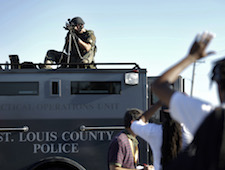Local television journalists from St. Louis covering the protests in Ferguson, Missouri tell Poynter.org there is a version of the story unfolding that has not been widely told. These journalists say it’s true that some officers have come at them with weapons drawn but others have shown remarkable restraint.
KTVI photojournalist Dave Sharp was hit in the thigh by a rubber bullet Wednesday night. “It’s no big deal,” the 26-year news veteran said. “Look, the police gave everyone a lot of warning to get out of there.” Sharp captured video of a young man tossing a lit firebomb toward police. “He tried to throw it over a building and it landed on a car wash. The car wash caught fire. If it had gone further, the molotov cocktail would have landed on a group of police gathered nearby. That is what started things Wednesday night. Just imagine what would have happened if that guy had thrown that thing a little further, it would have set a lot of officers on fire.”
KTVI photojournalist Wade Smith, a 30 year journalism veteran, says he has been covering the disturbances “every night since the story began in Ferguson.” Wednesday night, as tear gas canisters and rubber bullets flew, Smith said he was “inside the perimeter” that police set up around 6 o’clock each evening. “The way it works is that there are people who protest during the day, then around 6, police put up barriers and if you are not inside those barriers, you are outside the action.”
Protestors could not have been surprised when police began trying to clear the streets of Ferguson Wednesday night, Smith said. “I said to another person out there last night it is like the police are playing Jedi mind games. They are on loudspeakers saying things like ‘You have the right to protest. Stay off the road. Go to the side.'”
Then after police try that for a while, they said something like “OK you have to go now” and they start moving, Smith said. “Then, there is a tone — like the ski racers on the Olympics — There is a tone that they sound and they start moving and firing.” Smith said, “It was the urban equivalent of the Running of the Bulls, you know something bad is going to happen really soon.”
“There is a lot of tension out there, no doubt,” Smith said, “But honestly what I saw was a lot of restraint. I was all ‘yes sir and no sir’ and the police treated me with respect.” Smith said he did see many “independent” journalists, bloggers and others with small cameras, not TV cameras working “right up in the SWAT team’s faces.” Smith said, “I just kept thinking man, you might want to back up. But the officers didn’t do anything to them.”
KSDK photojournalist Eric Voss, who has 20 years of journalism experience, captured the now iconic video of police firing a tear gas canister at an Al Jezeera America TV crew.
“I was shooting a story on the opening of school being delayed. We were outside of the protest area in a neighborhood and the Al Jezeera crew was a half block away. Police formed a line and started moving and the Al Jezeera crew yelled ‘we are the press, we are the press, we are the press.'” Voss said police fired a tear gas canister that bounced off the crew’s vehicle. “The journalists ran away and I saw the police disassemble their lights and tilt the camera to the ground, they left it on the tripod.” Then, Voss said, police turned their attention on him. “When they got 20 or 30 feet away from me with their guns drawn I got out of there. I got in my car and threw both of my hands in the air.” Voss said there were no protestors anywhere near where the place he was when police confronted him.
KTVI’s Dave Sharp said he saw many people with mobile phones “trying to put themselves in the middle of the action,sounding like ‘oh the humanity.’ You could tell who was there to do their job as journalists who who just wanted to put themselves in the middle of the action,” he said.
The journalists I spoke with gave me examples of how some officers went out of their way to be helpful while others threatened journalists.
KSDK multimedia journalist Casey Nolen said that Tuesday night, the Ferguson Police Department’s public information officer called his station to say the station should alert journalists on the scene that police were going to use tear gas soon. “It was a ‘not for broadcast’ alert that they gave us. KSDK photojournalist Tom Herman captured video of police confronting a protestor. Police spotted Herman, shined a light directly at him, and second later, without warning, fired a beanbag round at him that pinged off his tripod.
KTVI photojournalist Wade Smith’s Facebook post from Ferguson, Missouri may have been the understatement of the night Wednesday. He posted a photo that he captured from his car with the caption, “Getting gas is no fun.”








